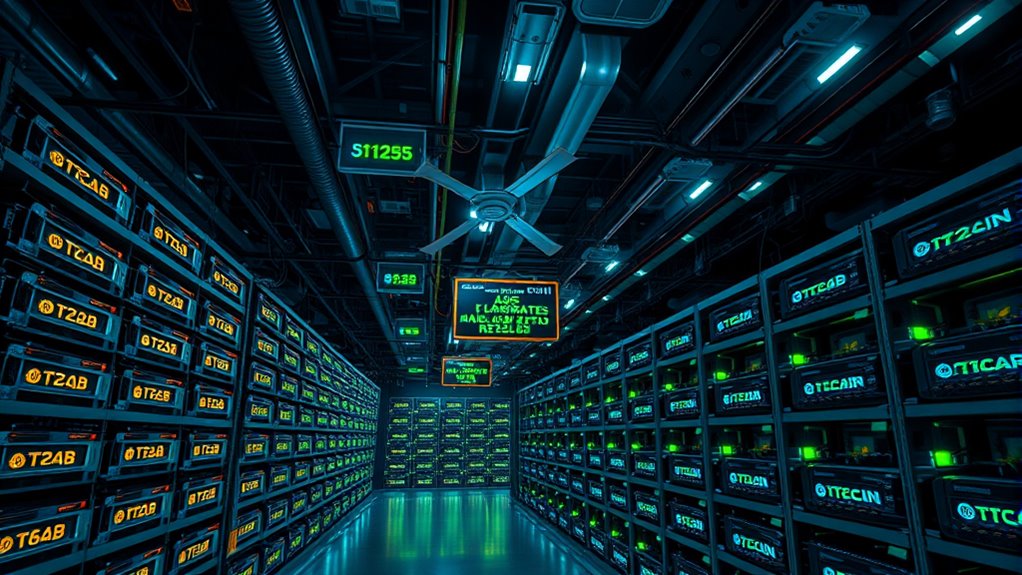By 2025, Bitcoin mining reaches new heights with record-breaking hashrates and increased difficulty, driven by advanced, energy-efficient hardware innovations. As miners compete with higher processing power, network security strengthens but entry becomes tougher for smaller players. Many miners are shifting to renewables, balancing sustainability and profitability amid evolving regulations. If you stay tuned, you’ll discover how industry efforts shape this exciting, resilient future of Bitcoin mining.
Key Takeaways
- Bitcoin’s hashrate is projected to reach new all-time highs driven by advanced, energy-efficient mining hardware.
- Mining difficulty will continue to adjust upward, maintaining 10-minute block targets amid increased network power.
- Industry efforts will focus on balancing high performance with sustainability, emphasizing renewable energy integration.
- Regulatory environments may influence hardware innovation and operational shifts toward regions with cleaner energy sources.
- Despite challenges, technological progress and increased security measures will push Bitcoin mining to record-breaking levels by 2025.

As Bitcoin mining evolves in 2025, it’s clear that technological advancements and shifting regulations are reshaping the landscape. You’re likely aware that mining’s energy consumption remains a hot topic, especially as more powerful hardware pushes the limits of efficiency. While newer ASICs and energy-efficient chips have reduced per-coin energy use, the overall energy demand continues to grow because of expanding mining operations. This surge raises concerns among regulators and environmental advocates alike, prompting governments worldwide to scrutinize the industry more closely. You might find that some countries impose stricter regulations or even bans on mining activities, citing environmental impacts and energy grid stresses. Others incentivize renewable energy use, aiming to balance profitability with sustainability. *Managing* these regulatory challenges means miners need to adapt quickly, often shifting operations to regions with cleaner power sources or more favorable policies. This ongoing regulatory flux influences investment decisions, operational strategies, and the pace of technological innovation. Additionally, the adoption of AI security solutions can help mining operations monitor and optimize their energy consumption more effectively, aligning with sustainability goals.
Meanwhile, the technical side of Bitcoin mining is breaking records regularly. You see hashrate reaching new heights, driven by advancements in hardware that deliver unprecedented processing power. Mining difficulty adjusts dynamically to maintain a roughly 10-minute block time, but with the influx of more powerful miners, it’s constantly on the rise. This means you need increasingly sophisticated equipment to stay competitive, which can be a double-edged sword. The high difficulty level ensures network security but also raises barriers to entry for smaller miners. To keep up, many are investing in state-of-the-art hardware and optimizing their setups for maximum efficiency. The result is a continuous cycle of innovation, with each new record pushing the network’s resilience and decentralization further.
Despite these technical achievements, the energy consumption associated with such growth remains a concern. You might notice that some miners are actively seeking renewable energy sources, reducing their carbon footprint to align with stricter regulations and public expectations. Governments and industry players are also collaborating on solutions to make mining more sustainable, such as integrating excess renewable energy or developing more energy-efficient mining algorithms. These efforts aim to balance the technical pursuit of higher hashrates and lower difficulty with the need to address environmental and regulatory challenges. As you observe the landscape in 2025, it’s evident that the industry is at a crossroads—pushing the boundaries of technology while confronting the realities of energy use and regulation, shaping a future for Bitcoin mining that’s both innovative and responsible.
Frequently Asked Questions
How Will Energy Consumption Impact Bitcoin Mining Sustainability in 2025?
Energy consumption will considerably impact Bitcoin mining sustainability in 2025. You’ll find that improving energy efficiency can reduce the carbon footprint, making mining more eco-friendly. As miners adopt greener technologies and renewable energy sources, the overall environmental impact decreases. This shift not only promotes sustainability but also helps miners comply with regulations and attract eco-conscious investors, ensuring the long-term viability of Bitcoin mining.
What Are the Latest Technological Advancements in Mining Hardware?
You’ll see significant advancements in mining hardware, focusing on ASIC efficiency and the potential of quantum computing. New ASICs now deliver higher performance with lower energy consumption, making mining more sustainable. Meanwhile, quantum computing is on the horizon, promising to revolutionize the industry by exponentially increasing processing power. These breakthroughs will help you mine more effectively, reduce costs, and address energy concerns, shaping Bitcoin’s future landscape.
How Might Regulatory Changes Affect Mining Operations Globally?
Coincidentally, regulatory changes could critically impact your mining operations worldwide. You might face stricter standards for regulatory compliance or new international policies that complicate cross-border activities. These shifts could lead to increased costs, operational adjustments, or even bans in certain regions. Staying adaptable and informed will be vital, as global policy updates directly influence your ability to mine efficiently and profitably in this evolving landscape.
What Role Will Renewable Energy Play in Future Mining Farms?
You will see renewable energy playing a vital role in future mining farms, as renewable integration becomes more widespread. By adopting sustainable practices, mining operations can reduce their carbon footprint and improve efficiency. This shift not only aligns with global efforts to combat climate change but also offers cost savings over time. As technology advances, expect more mining farms to utilize solar, wind, and hydro power for cleaner, more sustainable Bitcoin mining.
How Do Market Fluctuations Influence Mining Profitability in 2025?
Market fluctuations considerably impact your mining profitability in 2025, as price volatility can cause sudden gains or losses. When market trends favor higher Bitcoin prices, your mining rewards increase, making operations more profitable. Conversely, downturns reduce margins and may force you to reassess costs. Staying updated on market trends and analyzing price volatility helps you optimize mining strategies, ensuring you adapt quickly to changing conditions for sustained profitability.
Conclusion
By 2025, Bitcoin mining has become a relentless ocean of innovation, where each new record is a towering wave cresting higher than the last. As you navigate this ever-changing landscape, remember that the hashrate and difficulty are the currents shaping your journey. Embrace the challenge, for in this digital sea, only the strongest and most adaptable will ride the crest of success, carving their mark in the shimmering horizon of cryptocurrency’s future.









